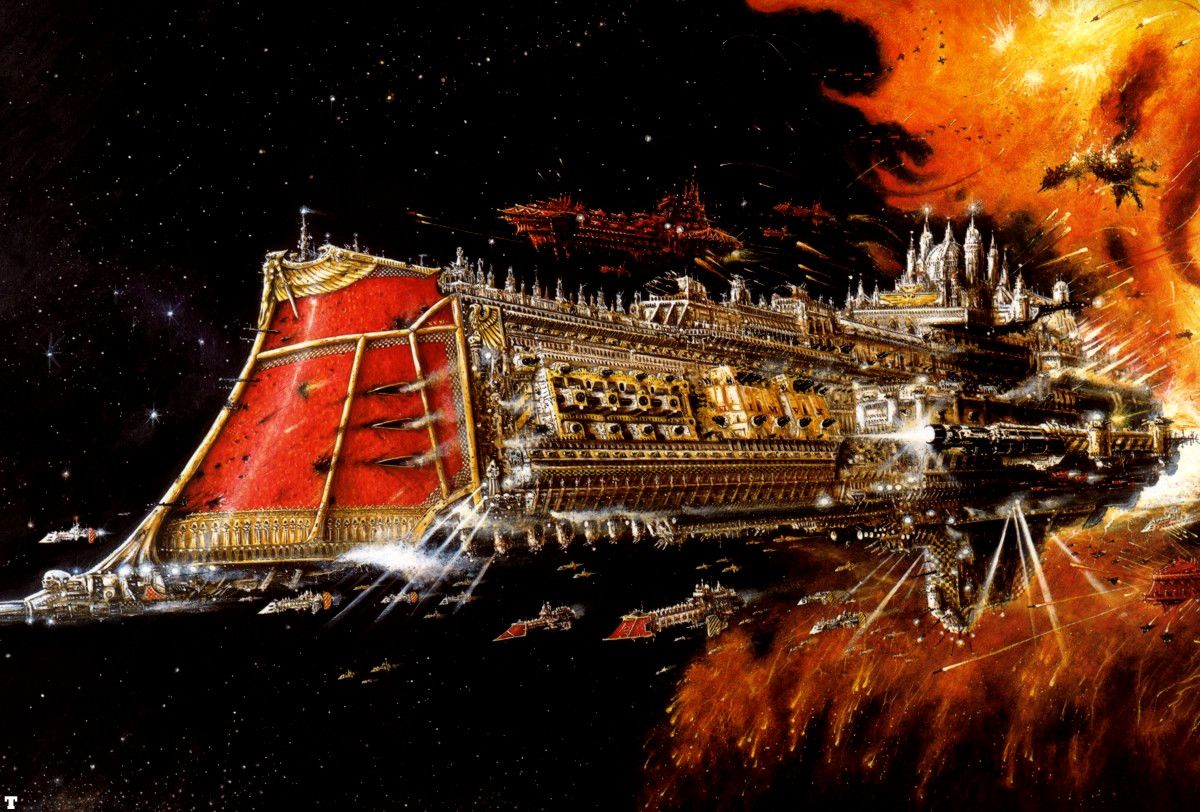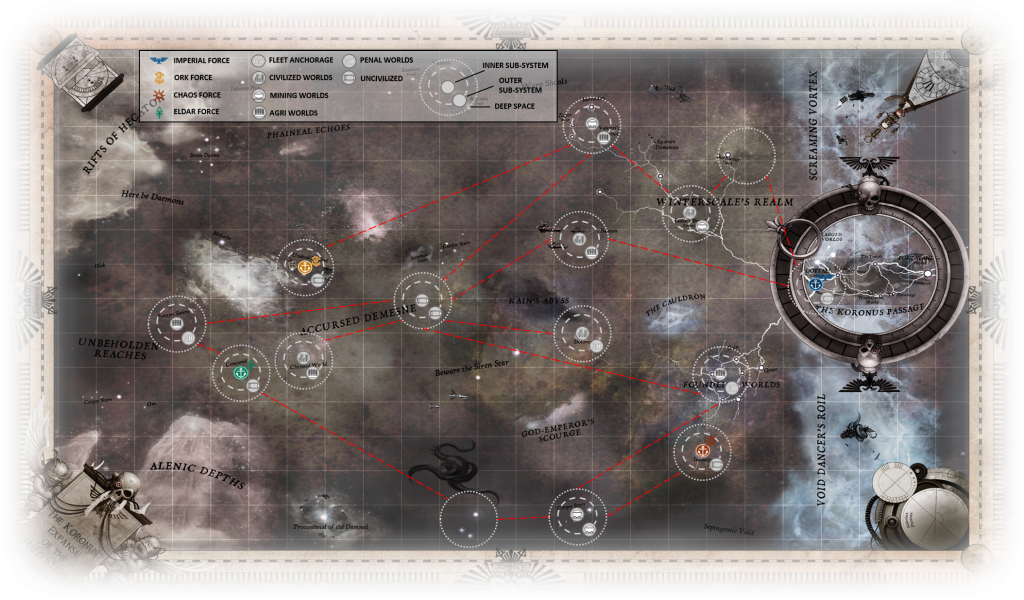Following on the heels of our Goonhammer introduction of Battlefleet Gothic we are excited to introduce a brand new series that covers a live, ongoing campaign that brings together the Battlefleet Gothic system and the Warhammer 40,000 Crusade system into a single integrated, narrative, and map-based campaign. Over the next months to year, four players will duke it out over the region of space known as the Koronus Expanse under the faint glow of the Halo stars. Today we’ll introduce the campaign setting, the players, and the rules of the campaign.
The Campaign Setting
Beyond the Calixis Sector of Segmentum Obscurus, in the furthest reaches of the galactic northwest, lies a wild region of space beneath the light of the Halo Stars known as the Koronus Expanse. Isolated by raging warp storms and accessible to Imperial navigators only through the tumultuous Koronus Passage, the region has long been the sole domain of adventuring rogue traders, xenos empires, and those who seek to escape the reach of the Emperor’s light. In the age of the Emperor’s Great Crusade, the Koronus Expanse, like the Calixis Sector itself, escaped the embrace of the Imperium and in the millennia since has remained a largely unexplored and little settled edge of the galaxy – it’s vast wealth and secret relics safely hidden away.
It’s little wonder then, that in such an untamed region of space, that danger looms ever present as evidenced by the countless graveyards of voidships drifting lifelessly and bathed in the faint glow of the Halo stars. Reports of piracy, unknown xenos attacks, and the disappearance of Imperial explorators abound, commonly without a trace. And yet, the Imperium of Man persists. Following on the heels of those Rogue Traders seeking to make a name for themselves, amidst their vain search for wealth and glory, Imperial colonists continually push out from their final safe haven at Port Wander in the Calixis Sector to establish an Imperial foothold. For centuries a slow flood has led to the establishment of a number of Imperial worlds and systems, bringing a small measure of order amidst the turmoil. However, such encroachment is not without notice…
The ever-present forces of Chaos, like flies to a corpse, have been increasingly encountered within Imperial space. Planetary governors determinedly stamp out the filth wherever they’re found, but for every cult to the foul gods rooted out, it seems three more spring up. Raiding activity along the fringes of the Expanse has increased and most concerning, there have been reports of an ancient explorator fleet, long thought lost, now returned and in service to the dark gods. As if the threat of Chaos wasn’t troubling enough, Rogue Traders have reported an increase in xenos activity. A new Warboss has arisen amongst the long dormant Ork worlds of the Undred-Undred Teef – stirring the clans into a frothing rage as the threat and terror of a Waaagh grips the western-most colonies. And yet another threat exists amongst the stars – the Aeldari known as the Crow Spirits have been sighted in the vicinity of the Alenic Depths – their purpose wholly unknown to the Imperium.
The Founding of a Sector
The opening of the Cicatrix Maledictum in 999.M41 marked a turning point for the Imperium of Man but specifically the Segmentum Obscurus. Finding itself torn in half with countless worlds engulfed by the rift and a majority of sectors isolated from the light of Holy Terra the Segmentum found itself at war on all fronts. Long the most embattled of segmentum’s within the Imperium, the Great Rift forced the forces of Obscurus into a desperate fight not just for survival, but to hold the tattered remnants of the Imperial order within the segmentum together. Following the success of the Indomitus Crusade and the stabilization of the Imperium Sanctus, Lord Commander Dante of the Blood Angels was proclaimed Regent of the Imperium Nihilus by the Primarch Roboute Guilliman. Understanding the desperate need for resources, the Lord Commander ordered a bitterly contested crusade to bring the rumored wealth of the Koronus Expanse under Imperial control. Led by Imperial Navy vessels drawn from across the Segmentum, each a precioius resource pulled off station at great risk, and supported by a contingent of the Crimson Fists chapter of Space Marines, the Crusade forces began amassing in the Calixis Sector at Port Wander – preparing the departure for Footfall and the establishment of a new Imperial Sector.
The Irontoof Waaagh
The war-torn worlds known as the Undred-Undred Teef have been an Ork-infested region of space since their first discovery. While the Teef have been the most concentrated collection of Orks within the Expanse, no leader has yet arisen with the strength to unite the tribes across the various worlds to a singular purpose. As Freebooterz Kaptins ply the stars and occasionally attempt to assert their dominance over the Teef, they’ve inevitably met with failure and death. However, it has been said that a new Warboss has arisen at the head of the banner of the Black Axe tribe, a cunning and brutal beast. Murderous, it has cut down those bosses and chiefs who have dared to stand in its path. Gorekoff Irontoof as he is known to the Greenskins is said to have been building a vast fleet of gunships to take his fight to the stars beyond the Teef, joined by those Freebooterz who’ve crossed his path, his purpose is not yet known. But the fear of a great Waaagh through the Expanse grows by the day.
A Lost Expedition
Early in M38, before the founding of the Calixis Sector, a trove of ancient and fragmented documents was discovered deep in the Segmentum Obscurus naval records vault at Wykthorne Prime detailing a path through the warp storms at the edge of the Calyx Expanse. The degraded records, later known as the Koronus Fragments, were the only known communicae of an Ad Mech Explorator fleet believed lost. However, recent raids on outlying Imperial outposts have been reportedly joined by Dark Mechanicus of unknown origins and leaving some at the highest levels of the Segmentum Fleet HQ on Cyprus Mundi to speculate that the ill-fortuned explorator fleet was never lost to the ravages of the void, but rather the powers of Chaos.
Ghosts in the Void
In the darkest regions of the Expanse, at the edges of the Alenic Depths, a number of reports of attacks from pale, swift voidships have been initiated before being abruptly cut. Scouting vessels dispatched in the region, seeking to substantiate the reports, have failed to report back or even return at all. Whispers of the return of a band of Aeldari known as the Crow Spirits, a particularly capricious sect of Corsairs known to have operated within the Expanse centuries ago, have found their way to the ears of the Inquisition. Inquisitor Riza Knas has taken a keen interest in these whispers… and silenced those who’s lips they’ve passed lest a panic of the menace spreads through the Imperial colonies.
The Active Factions
The campaign players are comprised of four members of the Frozen North Gaming Club in the Twin Cities region of Minnesota.
Logan Payne
The grounding rod of the Frozen North team, Logan hails from the St. Cloud area of Minnesota on the front lines of the sheer boredom that is the upstate flat lands. As a result he has a lot of free time to consider new and exciting team chat sarcasm and low-hanging, ego-busting quips. He is known for his love of sugary, bacteria riddled birthday cakes and early morning, pre-GT food poisoning.
- BFG Faction: Chaos Incursion Fleet
- 40k Crusade Faction: Dark Mechanicus (played as Adeptus Mechanicus)
Jack Esseff
“Record scratch, freeze frame Yup that’s me, and you’re probably wondering how I got to be on a goonhammer article (author’s note: no one is wondering). Well it all started in 2006 when I thought dryads were cool and from there it blossomed to me being one of Minnesota’s okayest Ork players.”
As you can see by his dryad obsession, Jack is a tree and plant-life fetishist and will unsolicited tell you everything you never wanted to know about the flora that has crossed his path. Small wonder then that he has gravitated to Orkdom like some kind of nature spore wizard. He is a connoisseur of energy drinks and Viper sunglasses.
- BFG Faction: Ork Waaaagh Fleet
- 40k Crusade: Orks
Axel Johnson
Axel is an entrepreneur and proprietor of Next Level Wargames and will likely host much of the chicanery to follow in this campaign. He is a vocal and determined advocate of two things – overly masculine figures and battle piles. It’s no small wonder then that he loves Space Marines and try’s to play them at an overwhelmingly mediocre rate. When he’s not winning precisely half his games he’s trying to introduce new players into 40k via Crusade.
- BFG Faction: Imperial Navy
- 40k Cruade: Crimson Fists
 James “Boon” Kelling
James “Boon” Kelling
A broken husk of a man since the release of the Iron Hands back in October of last year, James is a recovering salt purveyor and unfortunate victim of Eldar fandom. As a Goonhammer contributor, lead author of the recent Battlefleet Gothic review, and the architect of the current campaign he will author all articles relating to the ongoing campaign, and since he doesn’t particularly care about the conflicts of interest, it won’t be surprising to know that Eldar win… Elf. Bullshit.
- BFG Faction: Eldar Corsairs
- 40k Crusade: Craftworld Eldar
The Campaign Rules
In designing this campaign I’ve tried to keep a thought towards balance and offsetting the snowball effects that often takes place during mid-to-late campaigns. As a result, the campaign map has been designed such that it doesn’t result in a simple linear fight and doesn’t facilitate choke points that allows one player to simply dominate higher resource worlds. Once designed, the map has been layered into the Koronus Expanse geography to facilitate the narrative aspect of the campaign.
The Campaign Map
There will be 13 starting star systems comprised of:
- 4 Anchorage Star Systems
- 9 Uncontrolled Star Systems
- 2 Deep Space Systems
Each star system is comprised of:
- Inner sub-system
- Outer sub-system
- Deep space
Star systems act as a grouping of ‘sub-systems’ where in order to access the inner system you must first move through deep space and then the outer system (and vice versa). The transition between inner, outer, and deep space layers – these transitions are considered a space lane. Deep space is the outermost layer and a player may either move into the system from here or alternatively, move to another star system. The connecting routes between star systems are also space lanes.
Inner and outer sub-systems are comprised of various planet types that provide campaign bonuses to the player who controls them. To benefit from the planetary bonuses at the end of each campaign turn, a player must control or contest all space lanes to the planet and the position of their fleet marker. For example, if an opposing player is controlling the space lane in an outer system they effectively blockade any bonuses from those worlds and those which are more interior, however, they will not blockade the deep space traffic (and any connecting nearby star systems) without being positioned in deep space.
Fleet anchorages represent player starting positions and are an inner sub-system. These are for all intents and purposes “home base” and cannot be moved into by opposing players and are thus safe. Opposing players may interact with the outer and deep space sub-systems as normal.
The goal of the space lanes is to create logistical lines between a player’s planets and their fleets with the goal being a natural balance between a player’s offensive capacity and their need for repairs. Interdicted supply lines may not be immediately impactful to a player’s fleets, but as fleets engage in battle, a lack of repairs can have negative effects on their capacity to continue to push forwards and limits the snowballing in campaigns.
Selecting Starting Locations
Players will roll off to determine order for starting location selection.
Starting Forces and Force Limitations
Each player will create two rosters at the outset of the campaign, one for each game system, which are maintained and updated throughout the campaign. These rosters will be public for all players to review.
- Warhammer 40,000: Each player will develop a 50 PL force in accordance with the Crusade 9th edition ruleset. New rules updates are applied to the rosters upon release.
- Battlefleet Gothic: Each player will develop a 600-point fleet list following normal fleet construction guidelines with the following exception:
- A fleet commander may not be selected (though additional Chaos Lords or Ork Warbosses as ship upgrades may be purchased as normal)
- Instead each player will be assigned a fleet commander with the following profile to represent them:
- Imperial: Commander, Leadership 8, 1 Re-roll, 1 renown
- Chaos: Champion, Leadership 8, 1 Re-roll, 1 renown
- Ork: Nob, 1 Re-roll, 1 renown
- Eldar: Captain, Leader +0, 1 Re-roll, 1 renown
- New forces may be added as the campaign progresses, this is covered under the Requisition Phase.
The idea here is to start the campaign small and allow players to build their forces as the campaign advances while providing a balance and ensuring even engagements. This serves a few purposes:
- Allows players to build experience with the game systems and learn and improve without overwhelming
- Allows customization by building everything from the ground up and facilitating a narrative arc
- Encourages engagement with opposing players
Ultimately,40k Crusade is a highly polished and popular version of the game, so I try to avoid modifying the game where possible and instead rely on it being used by campaign map triggers rather than being directly impacted by the campaign map (by including planetary resources in 40k crusade as reinforcements, etc). This helps to reduce the complexity and expedite the campaign turn.
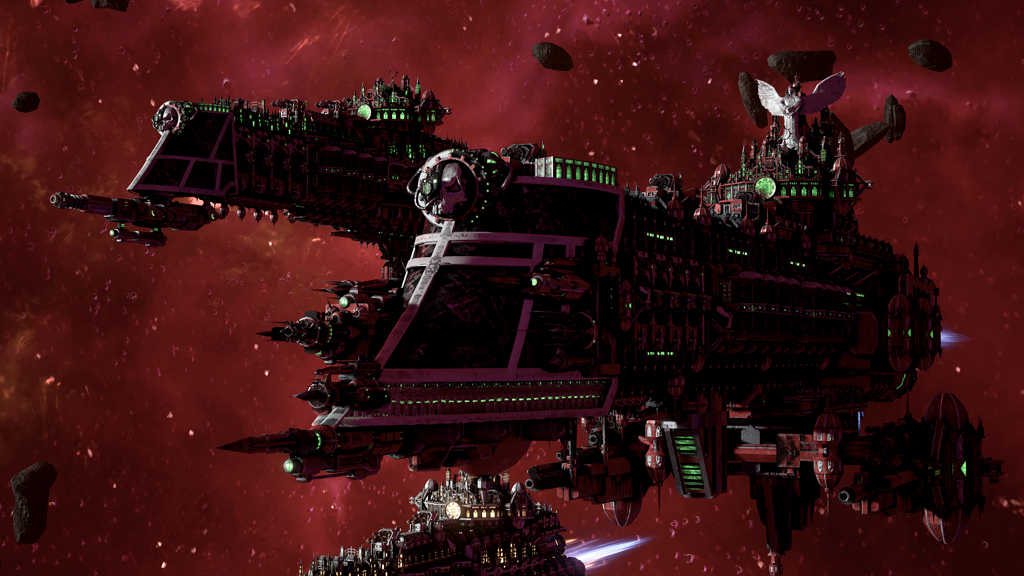
The Campaign Turn
The campaign turn consists of three phases:
- Player Phase: each player will take their turns as outlined in the rules below
- Requisition Phase: following the completion of all player’s turns, players may requisition new forces.
- End Phase: new units and post-battle adjustments are added to the respective Battlefleet Gothic and Warhammer 40,000 rosters and finalized.
Player Phase
Player Turn Order
The player turn order will be determined for the first turn in the inverse order in which starting locations were selected. This means that the player who chose their starting position last will have the first turn. The turn order will then be determined by the following pattern:
- Turn One: P1, P2, P3, P4
- Turn Two: P2, P1, P4, P3
- Turn Three: P3, P4, P1, P2
- Turn Four: P4, P3, P2, P1
- Turn Five: Repeat turn one. Ensuing turns follow the same order as above.
The reasoning for this turn order is prevent the player going last from always going last, and vice versa. The average position of all players is 2.5 in each four turn set, but the time between turns will vary and may force an extra wrinkle for some players to consider in their campaign planning.
The Player Turn
Each player turn will consist of the following elements. Once all players have completed these elements, the player phase will end and players will move into the requisition phase.
- Resolve Campaign Actions and Fight Battles
- Post-Battle Administration
- Update Campaign Map
Campaign Actions
On their turn, players may choose from three actions below to undertake (Move Forces, Planetary Invasion, Fleet Engagement). Each action may be repeated any number of times during their turn until their available actions are exhausted. A fourth action (Withdraw) may be taken by an opponent who has been attacked and is a response action taken on another player’s turn. Each player may take 3 actions during their turn.
- Move Forces
- Planetary Invasion
- Fleet Engagement
- Withdraw
Move Forces: This action allows a player to move the fleet marker to any adjacent system or sub-system location via a space lane. Players may move their fleets past opposing fleets and even occupy the same sub-system without engaging.
Planetary Invasion: The action may be taken by a player who controls the space within an unoccupied or enemy inner or outer sub-system. This action may not be taken in deep space sub-systems. If this action is taken on an opponent controlled sub-system, then a game of Warhammer 40,000 will be initiated. The winner will gain control of the planets in the sub-system. In the event of a draw, the battle is inconclusive and no changes to the campaign map are made. If the sub-system is unoccupied then the player automatically gains control.
Fleet Engagement: This action may be taken by a player when co-located in any sub-system with an opponent’s fleet. This will trigger a game of Battlefleet Gothic. The loser of the engagement is forced to withdraw as if a withdraw action had been taken, however, they will not lose an action in their next turn. In the event of a draw, no changes to the campaign map are made.
Withdraw: This action may only be taken as a response to a Planetary Invasion or Fleet Engagement action by an opposing player and results in an immediate loss in either Battlefleet Gothic or Warhammer 40,000. This action may only be taken by each player twice in a campaign turn in response to Fleet Engagement actions but is not limited for Planetary Invasion actions.
- In games of Warhammer 40,000, the player will forfeit the game and lose the territory but suffer no further consequences.
- In games of Battlefleet Gothic, the player will forfeit the game and lose one action in their following turn. Additionally, the player will be forced to withdraw to the nearest friendly space as follows:
- If in a sub-system where the player controls the more interior sub-system, the fleet will be withdrawn to the adjacent sub-system (example: the battle is fought in deep space and the withdrawing player controls the inner system, the fleet will be withdrawn into the outer system).
- If in an outer sub-system where the player does NOT control the adjacent inner sub-system, the fleet will be withdrawn outwards (example: the battle is fought in an outer system and the withdrawing player does not control the inner system, the fleet will be withdrawn to deep space).
- If in deep space where the player does NOT control a more interior sub-system, the fleet will be withdrawn to an adjacent star system and towards a friendly star system.
The intention of a retreat for Fleet Engagements is to allow some flexibility to a defending player who may hope to extend time until they’re ultimately forced to engage. While they can run for a time, it will cost them an action in their next turn which limits their offensive capability but may buy time for critical repairs. As we will see momentarily, defending planetary forces do not count towards a defender’s Crusade forces experience, thus the loss of the territory is the only immediate result. Additionally, having the mechanism for a retreat allows players who are unable to get a game in make a decision to keep the campaign moving.
Fighting Battles
Fighting a Fleet Engagement or Planetary Assault is resolved as follows:
- Battlefleet Gothic battles will be a fixed, universal size for all games. At the outset of the campaign and until determined otherwise, the Battlefleet Gothic battle size will be capped at 750 points. The size of the battles may be increased over the course of the campaign with player consensus.
- Players will select their fleets from vessels within their fleet roster up to the battle points cap
- Ships selected from the fleet roster need not comply with the fleet construction rules (the roster itself must)
- Flagships need not participate in a battle
- For games of Warhammer 40,000:
- Games will use Crusade missions with modifications as required by player consensus
- The attacking player will choose units in accordance with the Crusade rules. Additionally, the attacking player will gain D3 Orbital Bombardments before the start of the first turn.
- The defending player may build an army up to match the attacking player’s army point size using the standard Crusade force construction rules. Additionally, the defending player may select up to 10 PL additional units.
- The winner of the battle will gain or retain control of the sub-system. In the event of a draw, no changes will be made to the campaign map.
- The attacker will note all Crusade related administration for the battle. As the defender is not using their Crusade forces, they will not have any Crusade-related administration.
The idea is to ensure that battles remain evenly sized throughout the course of the campaign. The defenders gain a slight advantage in the early going by getting an additional 20% forces which is softened by the attacker’s control of space and their corresponding orbital bombardments – this helps to deter rapid domination of other players in the early game. However, as the Crusade forces gain in experience the advantage becomes less pronounced.
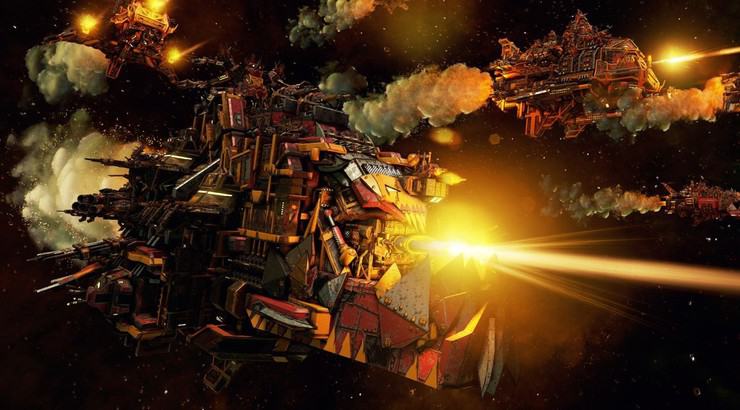
Post-Battle Administration:
Following a Planetary Assault, the attacker will account for Crusade administration as outlined in the Warhammer 40,000 9th Edition ruleset.
Following a Fleet Engagement, both players must account for Commander Renown and Ship Experience. This will be resolved as follows:
- Commanders
- Flagships which have been destroyed or left drifting in a battle that is lost will result in the loss of the commander
- In such a case, a new commander will be promoted from within the fleet at half renown (rounding up) of the original commander
- Do not adjust renown on the new commander
- Renown can never be adjusted to less than 1
- Commanders will gain renown whether they personally participate in the battle or not.
- Adjust renown as follows and reference the Commander’s Renown table to apply any updates to the fleet roster:
- +1 winning a battle
- +x (x = VPs / 100)
- +1 each drifting hulk captured
- +1 fought commander with higher renown
- -2 losing a battle
- -1 each capital ship lost
- Commander’s Renown Table
- Imperial Renown:
- 1-5: Commander Leadership 8, 1 Reroll
- 6-10: Battle Group Commander, Leadership 8, 2 Rerolls
- 11-20: Subsector Commander, Leadership 9, 2 Rerolls
- 21-30: Admiral, Leadership 9, 3 Rerolls
- 31-50: Fleet Admiral, Leadership 10, 3 Rerolls
- 51+: Solar Admiral, Leadership 10, 4 Rerolls
- Chaos Renown:
- 1-5: Chaos Champion, Leadership 8, 1 Reroll
- 6-10: Exalted Chaos Champion, Leadership 8, 1 Reroll, 1 Mark of Chaos
- 11-20: Tyrant, Leadership 9, 1 Reroll, 1 Mark of Chaos
- 21-30: Chaos Lord, Leadership 9, 1 Reroll, 2 Marks of Chaos
- 31-50: Overlord, Leadership 10, 1 Reroll, 2 Marks of Chaos
- 51+: Overlord, Leadership 10, 1 Reroll, 3 Marks of Chaos
- Eldar Renown
- 1-5: Captain, Leadership +0, 1 Reroll
- 6-10: Lord, Leadership +1, 1 Reroll
- 11-20: Shadow Lord, Leadership +1, 2 Rerolls
- 21-30: Prince, Leadership +2, 2 Rerolls
- 31-50: Shadow Prince, Leadership +2, 3 Rerolls
- 51+: King, Leadership +2, 4 Rerolls
- Ork Renown
- 1-5: Nob, 1 Reroll
- 6-10: Big Nob, 2 Rerolls
- 11-20: Boss, 2 Rerolls. 1 Warlord
- 21-30: Big Boss, 3 Rerolls, 1 Warlord
- 31-50: Warboss, 3 Rerolls, 2 Warlords
- 51+: Warlord, 4 Rerolls, 2 Warlords
- Ship Experience
- Ships and squadrons which fight in a battle and are not destroyed adjust experience as follows:
- First, ships crippled (or lose >50% of their squadron strength) lose 1 leadership
- Second, all surviving ships (including crippled) roll 2d6 and compare to the updated ship’s leadership, if the roll is higher than the leadership, the ship may select one of the following:
- Gain +1 leadership (max of 10)
- Select a crew skill
- Ships which are destroyed are automatically replaced in the fleet roster but lose all refits or skills and enter as leadership 6 (any race traits may then apply but it may never be lower than 6) – they do not take an experience roll
- A player may, instead, choose to spend banked requisition points to emergency requisition a similarly capable ship to replace the one lost in battle. Crew skills and leadership will be retained but refits and embarked commanders will still be lost. The player must pay the full cost of the vessel immediately.
- Crew Skills
- Expert Gunnery: May perform Lock On orders with 3d6 discarding the highest
- Skilled Engineers: May perform All Ahead Full or Burn Retros with 3d6 discarding the highest
- Adept Trimsman: May perform Come to New Heading with 3d6 discarding the highest
- Veteran Torpedomen: May perform Reload with 3d6 discarding the highest
- Excellent Pilots: Fighters may remain in play after intercepting ordnance on a 4+, Bombers may reroll their attack dice to determine the number of attacks
- Elite Command Crew: Once per battle the ship may automatically pass a leadership or command check
- Ships and squadrons which fight in a battle and are not destroyed adjust experience as follows:
- Imperial Renown:
- Flagships which have been destroyed or left drifting in a battle that is lost will result in the loss of the commander
This is similar to the structure of the Battlefleet Gothic core campaign management system. However, I’ve removed the randomness that comes with a lot of the early 90/00’s GW game systems as it’s simply more fun for player to design their fleets than it is to randomly level up. The capability to lose a commander is meant to provide a mechanism to players to mitigate the dreaded snowball effect.
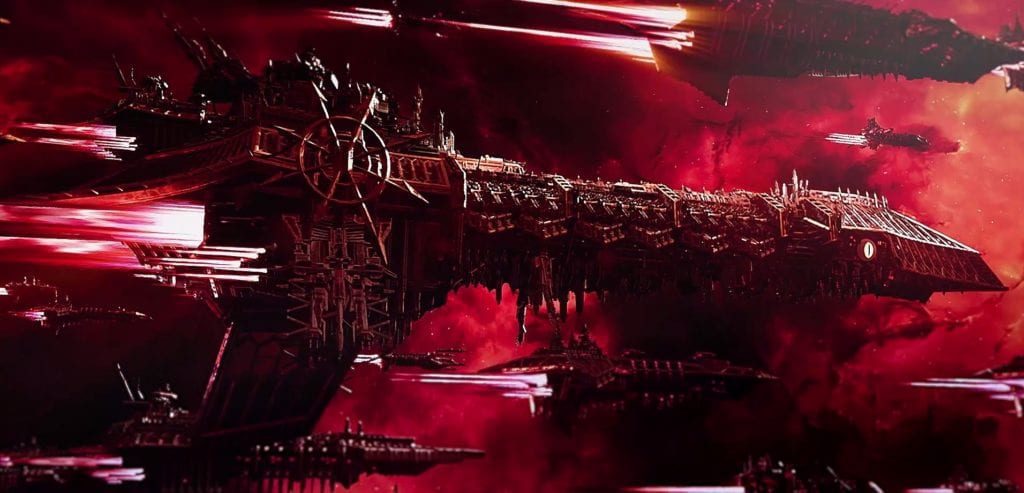
Requisition Phase
During the requisition phase all players will submit any new army or fleet changes, conduct repairs, requisition new units, refits, or abilities
Warhammer 40,000 Crusade
In accordance with Crusade rules.
Battlefleet Gothic
The requisition for BFG begins with fleet repairs and then proceeds to appeals for refits or new reinforcements and retirements. Proceed as follows:
- Fleet Repair: capacity is based on your total resource capacity generated by planets under your control for which you have a protected space lane. If an opponent’s fleet is interdicting a space lane but a friendly fleet is also in the region, then for purposes of repair this is considered a protected space lane.
- Total up all planetary capacity who can draw an uninterdiected space lane to your fleet. This capacity is based on your captain’s renown and the types of planets under your control. Refer to the below table:
- Renown 1-5: Agri 1, Penal 1, Mining 2, Fleet Anchorage 3, Civilized 1, Uninhabited 1
- Renown 6-10: Agri 1, Penal D6-4, Mining 2, Fleet Anchorage 3, Civilized 2, Uninhabited 1
- Renown 11-20: Agri 1, Penal D6-3, Mining 2, Fleet Anchorage 4, Civilized 3, Uninhabited 1
- Renown 21-30: Agri 2, Penal D6-2, Mining 2, Fleet Anchorage 5, Civilized 4, Uninhabited 1
- Renown 31-50: Agri 2, Penal D6-1, Mining 3, Fleet Anchorage 6, Civilized 5, Uninhabited 1
- Renown 51+: Agri 1, Penal D6, Mining 4, Fleet Anchorage 8, Civilized 6, Uninhabited 1
- For each point of capacity available, a surviving ship or squadron may repair a single hull point of damage – any unrepaired damage carries into the ensuing turns until repaired.
- Critical damage inflicted during a battle requires an additional repair point to repair beyond simply repairing the hull point.
- Alternatively, a ship may be withdrawn from the sector for full repairs. If this option is taken, the ship or squadron will be temporarily unavailable as it departs the sector for repair and returns. This will be 2 player turns.
- Total up all planetary capacity who can draw an uninterdiected space lane to your fleet. This capacity is based on your captain’s renown and the types of planets under your control. Refer to the below table:
- New Requisition: fleet requisitions come in two types; new units and current ship/squadron refits and are based on the number of appeals available.
- Appeals table:
- Renown 1-10: 1 Appeal – Automatically Granted
- Renown 11-30: 2 Appeals – Granted on a 2+
- Renown 31-50: 3 Appeals – Granted on a 3+
- Renown 51+: 4 Appeals – Granted on a 4+
- For each appeal granted you may request one of the two following options:
- 100 reinforcement points
- Ship refit
- Reinforcement points may be used to immediately purchase new ships or squadrons. However, points need not be used immediately but may instead be banked for a later purchase of larger vessels.
- New ships must be purchased in accordance with fleet construction guidelines.
- Newly added vessels roll for leadership normally.
- Battleships may not be purchased until the battle capacity has reached 1,250 points.
- Refits: Used to upgrade current vessel capabilities. If a refit is chosen via appeal then the player may select to upgrade one ship or squadron with one of the following capabilities from ship, engine, or weapon upgrades. Ships undergoing a refit are temporarily unavailable for one turn. A refit may only be chosen once per ship or squadron.
- Ship Refits:
- Improved Sensor Array: Ship gains +2 rather than +1 leadership to go on special orders if an enemy ships is on special orders.
- Additional Shield Generator: Ship gains +1 shield
- Superior Damage Control: Ship may roll one extra dice in the end phase to repair damage
- Reinforced Hull: The ship gains 25% (rounded up) more hit points but reduces speed by 5cm
- Improved Logic Engines: The ship does suffer -1 leadership for being in contact with blast markers
- Overload Shield Capacitors: For each hit against shields, roll a d6 – if a 6 is rolled the hit is ignored and no blast markers are placed
- Engine Refits:
- Secondary Reactors: The ship rolls an extra 2d6 when on All Ahead Full orders
- Evasive Jets: At the start of the enemy shoot phase, make a leadership check – if passed the ship may immediately make a 45-degree turn but may not go on special orders in its next turn (except Brace for Impact)
- Maneuvering Thrusters: The ship reduces mandatory movement before turns by 5cm
- Arrester Engines: The ship adds +1 to leadership rolls for Come to New Heading or Burn Retros special orders
- Auxiliary Power Relays: Gain +5 cm of movement
- Navigational Shields: The ship does not suffer movement penalties from celestial phenomena including blast markers
- Weapon Refits:
- Extra Turrets: The ship gains 1 turret
- Turbo-weapons: The ship does not suffer right-column shifts from weapon battery fire over 30cm
- Targeting Matrix: Weapon battery fire benefits from a left-column shift
- Auto-Loaders: The ship adds +1 to its leadership roll to Reload Ordnance
- Superior Fire Control: The ship adds +1 to leadership roll for Lock On
- Motion Tracking Targeters: While on All Ahead Full, Burn Retros, or Come to New Heading special orders, the ships firepower is only reduced by 25% (rounded up) rather than halved.
- Fleet Retirements: Ships or squadrons may be stricken from the roster and their points recouped at 75% value. However, a new vessel may not be purchased until the next campaign turn and all original ship refits and crew skills are lost.
- Flagship Change: A commander may move their flag to another vessel.
- Ship Refits:
- Appeals table:
There are two major components to the requisition phase, the first is the repair and the second is new ability or unit requisition. Here again we see that capacity is based on Commander renown, this is the real teeth behind the commander component that aims to slow snowball effects in the campaign. Further, appeals are not granted universally – as the campaign grows and more resources are requested, they may become harder to acquire as forces are stretched thin. Other than this component, the randomness to refits, like with crew skills, has been removed.
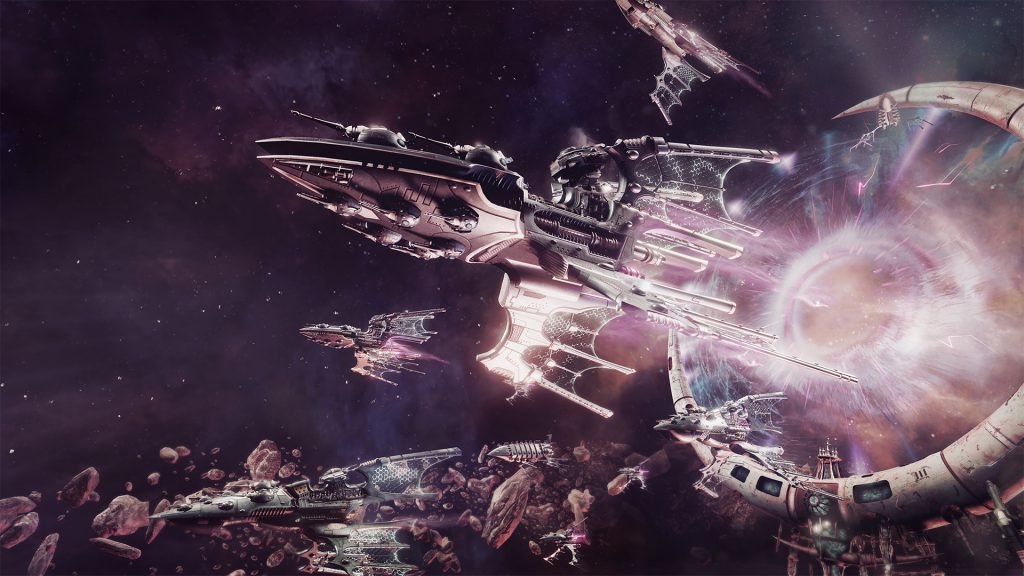
End Phase
All player roster changes for both Battlefleet Gothic and Warhammer 40,000 are finalized, collected, and made publicly available – this ends the campaign turn. Boon will consolidate notes for a campaign write up to be published periodically as the campaign progresses.
Final Thoughts
The campaign will begin shortly and is expected to last months and potentially over a year. Moving forward, periodic campaign updates will be published so interested readers who wish to follow the narrative as it plays out unfolds may do so! We’ll seek to provide battle reports for both Battlefleet Gothic and Warhammer 40,000 and ultimately hope that we can inspire you and your own gaming groups to think creatively!
Have any questions or feedback? Drop us a note in the comments below or email us at contact@goonhammer.com.
